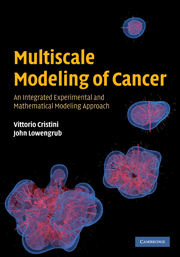10 - Agent-based cell modeling: application to breast cancer
from Part II - Applications
Published online by Cambridge University Press: 05 October 2010
Summary
In Chapter 6 we discussed an agent-based cell model that can be applied to a variety of biological systems, with a particular emphasis on epithelial cancers. We now illustrate the model by applying it to breast cancer and demonstrating its use in obtaining theoretical biologic and clinical insights, including quantitative predictions that can be assessed using patient immunohistochemistry and histopathology data. The theoretical biologic and clinical significance is discussed.
Introduction
Ductal carcinoma in situ (DCIS) is the most prevalent precursor to invasive breast cancer (IC), the second-leading cause of death in women in the United States. The American Cancer Society predicted that 50 000 new cases of DCIS alone (excluding lobular carcinoma in situ) and 180 000 new cases of IC would be diagnosed in 2007. Co-existing DCIS is expected in 80% of IC, or 144 000 cases. Because DCIS is a known precursor to IC, this leads us to hypothesize that up to 75% of DCIS cases progress to invasion prior to detection by screening mammography. While DCIS itself is not life-threatening, it is a very important precursor to IC because (i) it can be treated and (ii) if left untreated it is likely to progress to IC, which is a deadly disease.
Women tend to prefer breast-conserving surgery (BCS), also known as lumpectomy, to complete mastectomy for the treatment of DCIS: in the United States today, approximately two-thirds of women diagnosed with DCIS will opt for BCS over mastectomy. Women who undergo BCS face two problems.
- Type
- Chapter
- Information
- Multiscale Modeling of CancerAn Integrated Experimental and Mathematical Modeling Approach, pp. 206 - 234Publisher: Cambridge University PressPrint publication year: 2010
- 8
- Cited by



